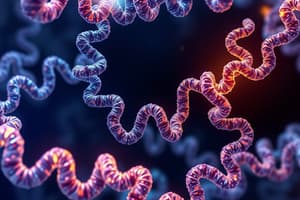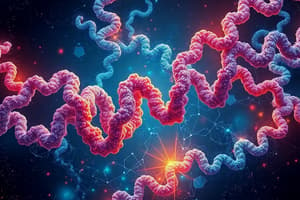Podcast
Questions and Answers
What percentage of human protein-protein interactions have either X-ray or NMR structures?
What percentage of human protein-protein interactions have either X-ray or NMR structures?
Deep learning methods have shown that heterodimers generally have weaker correlated mutations compared to homocomplexes.
Deep learning methods have shown that heterodimers generally have weaker correlated mutations compared to homocomplexes.
False (B)
What is the main improvement noted from CASP12 to CASP15?
What is the main improvement noted from CASP12 to CASP15?
Substantial improvement in protein-protein docking.
The technique used to combine sequences and predict structures using AI is called ________.
The technique used to combine sequences and predict structures using AI is called ________.
Signup and view all the answers
Match the terms with their correct descriptions:
Match the terms with their correct descriptions:
Signup and view all the answers
What is the primary function of the diffusions model in protein structure prediction?
What is the primary function of the diffusions model in protein structure prediction?
Signup and view all the answers
An important step in machine learning for protein docking is ensuring that homologous sequences are included in both training and validation datasets.
An important step in machine learning for protein docking is ensuring that homologous sequences are included in both training and validation datasets.
Signup and view all the answers
What do proteins need to exhibit for successful rigid body docking?
What do proteins need to exhibit for successful rigid body docking?
Signup and view all the answers
The primary aim of protein docking is to predict the structure of a complex starting with the __________ components.
The primary aim of protein docking is to predict the structure of a complex starting with the __________ components.
Signup and view all the answers
What is the significance of the PDB in relation to protein docking?
What is the significance of the PDB in relation to protein docking?
Signup and view all the answers
In ab initio docking, a template-based approach is preferred due to the limited number of known complexes.
In ab initio docking, a template-based approach is preferred due to the limited number of known complexes.
Signup and view all the answers
Match the following types of protein docking with their characteristics:
Match the following types of protein docking with their characteristics:
Signup and view all the answers
What does 'global search' refer to in the context of protein docking?
What does 'global search' refer to in the context of protein docking?
Signup and view all the answers
What metric measures the local agreement between two protein structures?
What metric measures the local agreement between two protein structures?
Signup and view all the answers
PLDDT values below 50 indicate a high degree of confidence in predictions.
PLDDT values below 50 indicate a high degree of confidence in predictions.
Signup and view all the answers
What does pLDDT stand for?
What does pLDDT stand for?
Signup and view all the answers
The __________ metric assesses how well the predicted distances between residues are aligned.
The __________ metric assesses how well the predicted distances between residues are aligned.
Signup and view all the answers
Which stage of AlphaFold2 involves calculating residue-residue contacts?
Which stage of AlphaFold2 involves calculating residue-residue contacts?
Signup and view all the answers
Match the following accuracy metrics with their descriptions:
Match the following accuracy metrics with their descriptions:
Signup and view all the answers
AlphaFold2 predicts high confidence for all residues in the human proteome.
AlphaFold2 predicts high confidence for all residues in the human proteome.
Signup and view all the answers
What algorithm is primarily used for refining structures in AlphaFold2?
What algorithm is primarily used for refining structures in AlphaFold2?
Signup and view all the answers
Flashcards
Correlated Mutations
Correlated Mutations
A method for predicting protein-protein interactions by analyzing evolutionary relationships between amino acids in different proteins.
AlphaFold2
AlphaFold2
A powerful tool for predicting protein structures, including protein complexes, using deep learning.
AlphaFold Multimer
AlphaFold Multimer
A version of AlphaFold2 designed to predict the structures of protein complexes.
Residue-Residue Interaction Scoring
Residue-Residue Interaction Scoring
Signup and view all the flashcards
Template Docking
Template Docking
Signup and view all the flashcards
Diffusion in protein structure prediction
Diffusion in protein structure prediction
Signup and view all the flashcards
Diffusion model in protein structure prediction
Diffusion model in protein structure prediction
Signup and view all the flashcards
Forward diffusion in protein structure prediction
Forward diffusion in protein structure prediction
Signup and view all the flashcards
Reverse diffusion in protein structure prediction
Reverse diffusion in protein structure prediction
Signup and view all the flashcards
Protein docking
Protein docking
Signup and view all the flashcards
Ab initio docking
Ab initio docking
Signup and view all the flashcards
Rigid body docking
Rigid body docking
Signup and view all the flashcards
Global search in protein docking
Global search in protein docking
Signup and view all the flashcards
What is a distogram in AlphaFold2?
What is a distogram in AlphaFold2?
Signup and view all the flashcards
How does AlphaFold2's two-track learning work?
How does AlphaFold2's two-track learning work?
Signup and view all the flashcards
What are the inputs for AlphaFold2?
What are the inputs for AlphaFold2?
Signup and view all the flashcards
What is pLDDT in AlphaFold2?
What is pLDDT in AlphaFold2?
Signup and view all the flashcards
What is PAE in AlphaFold2?
What is PAE in AlphaFold2?
Signup and view all the flashcards
How does AlphaFold2 refine its predictions?
How does AlphaFold2 refine its predictions?
Signup and view all the flashcards
What are some limitations of AlphaFold2?
What are some limitations of AlphaFold2?
Signup and view all the flashcards
What is a potential caveat of low PAE scores?
What is a potential caveat of low PAE scores?
Signup and view all the flashcards
Study Notes
Protein Structure Prediction
- Over 250 million protein sequences exist, but fewer than 110,000 structures are known. This represents a significant gap.
- The hypothesis is that a protein's sequence in an environment dictates its structure. Aiming to predict structure from a protein's sequence.
Reasons for Predicting Protein Structure
- To understand the relationship between sequence and structure.
- To predict protein function based on structure.
- To guide rational drug design.
- To aid in rational mutagenesis studies.
- To assist in deriving structures from experimental data.
Quantifying Predicted Model Accuracy
- RMSD (Root Mean Squared Deviation): A useful measure for similar structures. Typically, around 70 out of 90 superposed residues have an RMSD of 2.6 Å between a predicted and an experimental (x-ray) structure.
- RMSD Limitations: Evaluating RMSD becomes less accurate as the differences between predicted and real structures increase. Comparing RMSD values across proteins with different lengths is challenging.
- TM (Template Modelling): Removes arbitrary choices, such as maximum difference between equivalent residues. TM scores range from 0 to 1 and consider all residue equivalences. It is scaled by the length of the protein. A TM score > 0.5 indicates a good overall protein fold, while a value > 0.75 suggests a well-predicted structure.
Template-Based Modelling – Phyre2.2
- Query Sequence: The process starts with a query protein sequence.
- Database Search: The protein sequence is compared against a large database of known structures.
- Extracting Information: Secondary structure and sequence are extracted from known structures.
- Multiple Sequence Alignment (MSA): The sequence is run through PSI-BLAST to generate an MSA.
- Predicting Secondary Structure: The MSA is input into PSI-Pred to predict secondary structure.
- Hidden Markov Models (HMMs): Models are created and matched to the query sequence. This allows for identification of homologous structures and remote relationships in the database.
- Alignment and Refinement: An alignment between the query sequence and a known structure is created, and adjustments are made, considering residue insertions and deletions.
- Loop Modelling: Used to model insertions and deletions within the sequence based on the alignment and predicted structure.
Energy Minimisation
- The method aims to compute a protein's energy potential, adjust its bond geometry, and work towards the energy minimum to achieve a thermodynamically stable conformation.
- A challenge is getting trapped in local minima.
Secondary Structure Prediction
- This effort focuses on identifying local structural elements in a protein (α-helices, β-sheets, coils, and turns).
- Often, multiple aligned protein sequences are used to provide supplementary information.
Tertiary Structure Prediction
- Predicts the 3D arrangement of all amino acids in a protein.
- Template-based, template-free, and hybrid approaches (deep learning with templates) are employed.
Hybrid Prediction – AlphaFold2
- MSA (Multiple Sequence Alignment): Creates an alignment of sequences similar to the target sequence.
- Evoformer and Structure Networks: Calculating residue-residue contacts using deep learning networks.
- Refined Structure: Finally, a refined protein structure is generated.
- PLDDT (Predicted Local Distance Difference Test): Measures the accuracy of predicted structures. High values (> 90) indicate high accuracy.
Fragment-Based Prediction
- Builds tertiary structure from smaller fragments from a database, assuming that local sequence determines local structure.
- Fragments are constructed based on sequence alignment to known 3D arrangements of smaller structures.
- Reasonable predictions, but sometimes incomplete or require integration with template-based strategies.
- Uses evolutionary relationships (correlated mutations) to anticipate contacts between amino acid residues.
Language Models
- They predict connections between amino acids by considering known mutations in protein sequences from similar protein families for improved accuracy.
- Predicting residue-residue contacts to build a 3D structure using deep learning.
Protein Docking
- Predicting the structure of a complex of two or more protein molecules starting from their unbound structures. Important for understanding protein interactions.
- Approaches include ab initio methods (no template) and template-based methods.
- The primary methods are rigid body docking followed by refining the positions of side chains, aiming to predict the lowest energy conformation.
Studying That Suits You
Use AI to generate personalized quizzes and flashcards to suit your learning preferences.
Related Documents
Description
Explore the critical gap between known protein sequences and structures and the importance of predicting protein structure from sequence. This quiz covers the relationship between sequence and structure, methods for model accuracy quantification, and implications for drug design and mutagenesis studies.




